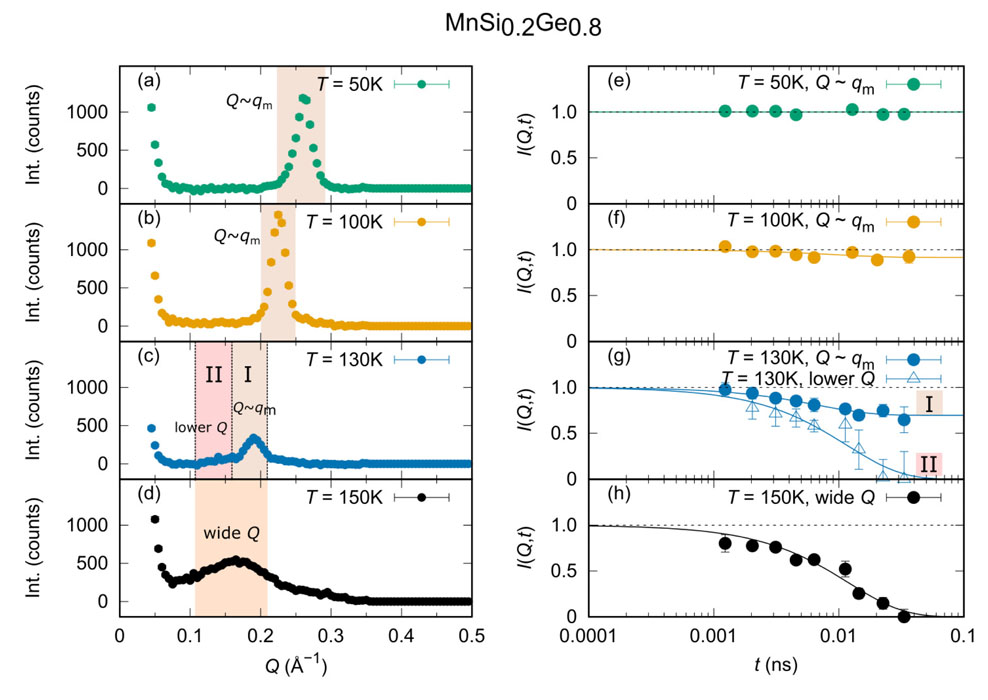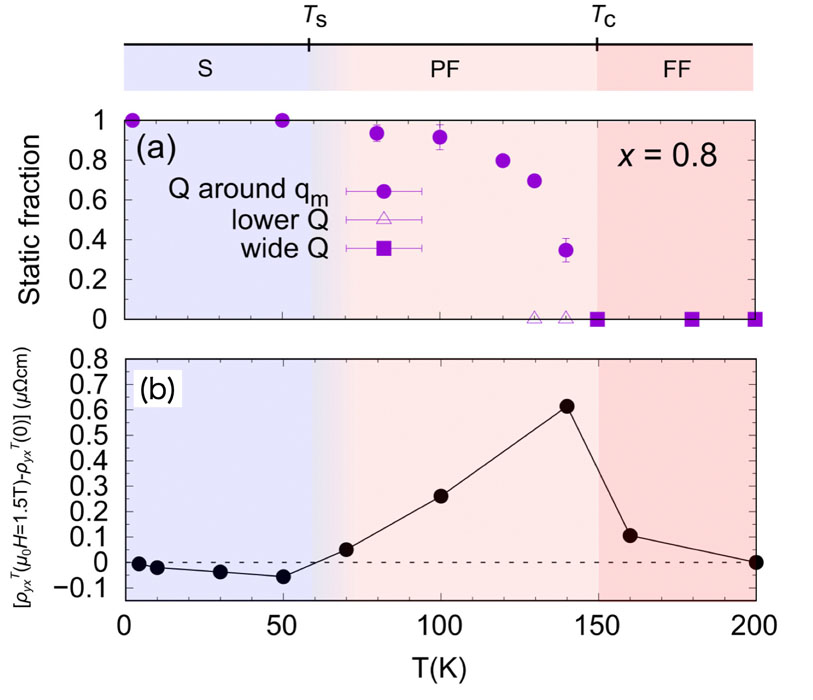Spin Fluctuations in Spin-Hedgehog-Anti-Hedgehog Lattice State in MnSi1-xGex
Nakajima Group
Couplings between topological magnetic orders and conduction electrons have been of increasing interest in recent condensed matter physics research [1,2]. One of the most well-known examples is the magnetic skyrmion lattice (SkL) discovered in a chiral cubic helimagnet MnSi [1]. The SkL is composed of topologically-nontrivial vortex like spin objects, which have finite scalar spin chirality, Si・(Sj × Sk), owing to the non-coplanar arrangements of the magnetic moments. The scalar spin chirality acts as an effective magnetic field for conduction electrons, and thus induces an unconventional Hall effect, which is known as Topological Hall Effect (THE). Another example of topological magnetic orders is a spin-hedgehog-anti-hedgehog (SHAH) lattice state discovered in MnGe [3], which is isostructural to MnSi. The spin arrangement of SHAH lattice is described by a superposition of three proper-screw-type magnetic modulations with the q-vectors of (q,0,0), (0,q,0) and (0,0,q). By calculating spatial distribution of the scalar spin chirality in the SHAH lattice, one can find that the spin texture can be viewed as periodic arrays of effective magnetic monopoles and antimonopoles. Although the effective magnetic fields in the SHAH lattice are cancelled to be zero in zero magnetic field, an application of an external magnetic fields and resulting distortion of the SHAH lattice can induce a finite THE. In addition to the THE mechanism for the long-range-ordered non-coplanar magnetic orders, a recent theoretical study [4] has pointed out that ‘fluctuating’ short range magnetic order with scalar spin chirality can induce skew scattering, which leads to Hall effect with opposite sign to that induced by the long-range non-coplanar orders.
In the present study, we investigate MnSi1-xGex, which exhibits a variety of Hall effects depending on temperature, magnetic field, and amount of the chemical substitution [5]. Specifically, we focus on x = 0.8 and 0.6 samples; the former exhibits the same SHAH lattice state as that in the x = 1 sample, while the latter shows another SHAH lattice state composed of four q-vectors, specifically (q,q,q), (q,–q,–q), (–q,q,–q) and (–q,–q,q) [5]. To understand the origins of the Hall effects in these systems, it is necessary to experimentally study the magnetic structures and their fluctuations by neutron scattering.
Figure 1 shows the results of the neutron scattering measurements on the x = 0.8 sample. The data was obtained at VIN ROSE (BL06) beamline in Materials and Life-science experimental Facility (MLF) of J-PARC. We used the powder sample of MnSi1-xGex with x = 0.8 used in the previous study in Ref. 5. Figures 1(a)–1(d) show the neutron diffraction profiles in the low-Q region. At low temperatures, a sharp magnetic Bragg peak was observed at around Q = 0.26 Å−1. As the temperature was increased, the intensity of the Bragg peak was reduced, and its position was shifted toward lower Q region. Finally, the Bragg peak disappeared above the critical temperature of 150 K, and instead, a broad diffuse scattering was observed at around Q = 0.15 Å−1.
Figures 1(e)–1(h) show the intermediate correlation function I(Q,t) deduced from the neutron resonance spin echo spectroscopy at VIN ROSE. The Q ranges used for the data reduction are indicated by colored area in Figs. 1(a)–1(d). At 50 K, the I(Q,t) remains very close to unity even at 0.03 ns, which is the upper limit of the time window of the present experiment, indicating that there is no spin fluctuations and that the magnetic moments are static. However, near the critical temperature, we observed the I(Q,t) curve shows the exponential decay, meaning that the spins are fluctuating with the characteristic time of approximately 0.01 ns. In Fig. 2(a), we show the fraction of the fluctuating spin components deduced form the neutron spin echo experiment as function of temperature, revealing that the spin fluctuations remain above 60 K. This shows a good agreement with the sign change of the additional Hall resistivity shown in Fig. 2(b); the additional component of the Hall resistivity changes from negative to positive at around 60 K. These observations demonstrated that the dominant contribution of the additional Hall resistivity changes from the static emergent magnetic field from the long-range-ordered SHAH lattice to the skew scattering due to the fluctuating spin cluster with scalar spin chirality as the temperature is increased. We also performed the neutron spin echo measurements on the x = 0.6 sample in the same manner as that for the x = 0.8 sample, and carried out inelastic neutron scattering experiments for both the x = 0.6 and 0.8 samples at HRC (BL12) in MLF of J-PARC. More detailed analysis will be published elsewhere [6].
References
- [1] S. Muhlbauer et al., Science 323, 915 (2009).
- [2] N. Nagaosa and Y. Tokura, Nat. Nanotech. 8, 899 (2013).
- [3] N. Kanazawa et al., Phys. Rev. Lett. 106, 156603 (2011).
- [4] H. Ishizuka and N. Nagaosa, Sci. Adv. 4, eaap9962 (2018).
- [5] Y. Fujishiro et al., Nat. Commun. 10, 1059 (2019).
- [6] S. Aji et al., arXiv:2305.01172


